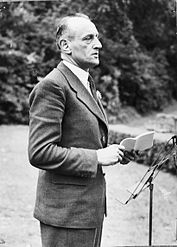Gerrit Jan van Heuven Goedhart's Human Design Chart
6/2 Emotional Manifesting GeneratorDutch journalist, diplomat and politician. From 1951–1956, he was the first United Nations High Commissioner for Refugees (UNHCR) after WW2.
He was the second of four sons of the Protestant army vicar and bookshop keeper Gijsbert Willem Goedhart (12 September 1877, Arnhem – 10 January 1952, Hilversum) and Francina Dingena Helena van Heuven (6 June 1872, Arnhem – 3 December 1919, Zwammerdam). After his mothers death his father remarried Trijntje Hofstra (21 July 1907, Assen – 6 June 1989, Hilversum) and got three other children.
Van Heuven Goedhart studied Law at Leiden University and graduated on 9 July 1926 with the thesis “De ontwikkeling der werkloosheidsverzekering in Nederland” (The development of the unemployment insurance in the Netherlands).
In 1925 he had already become a reporter for newspaper De Telegraaf, in 1926 he became editor. On 1 January 1930, he became the editor-in-chief of De Telegraaf. In March 1933, he refused to post the articles of the Berlin reporter J.M. Goedemans, who called the newly elected German leader Adolf Hitler “a great statesman”. Because of his principles, Goedhart was fired on 1 June 1933 by the Telegraaf directory board.
On 1 July 1933, he became editor in chief of the regional newspaper Utrechts Nieuwsblad, that grew under his leadership, until soon after the German invasion of the Netherlands, when on 17 May 1940, Goedhart was again fired “because of the changed political circumstances”.
In the late thirties, Goedhart (meaning Good heart) became a vivid supporter of the principles of free journalism. In their Dutch periodical De Journalist, Goedhart wrote: “A journalist who is inwardly free, is like a loudspeaker. He alone is “pick up” and has megaphone utility. Not as adviser, critic or customer of responsibility” (1 June 1938). Just tell the truth, and let the readers decide. The in democratic principles believing Goedhart became member and vice chairman of the “Comité van Waakzaamheid” against the National-Socialism, but was also an opponent of communism.
During the Second World War, Van Heuven Goedhart went underground and worked as a reporter and editor in chief for the illegal resistance newspaper Het Parool. His brother Jan was in 1942 executed by the Nazi’s. On 24 April 1944 he started to travel via France and Spain to arrive in London on 17 June 1944. From 12 July 1944 till 23 February 1945, he was Minister of Justice in the exile government of Gerbrandy.
After the Second World War, Van Heuven Goedhart returned to Het Parool, where he once again become editor in chief (27 August 1945). In 1947, he also became Senator for the Labour Party. Since 1947 he did jobs for the United Nations.
On 14 December 1950, the UN appointed him as the first High Commissioner for Refugees (UNHCR). Under Van Heuven Goedhart, the UNHCR was awarded on the 1954 Nobel Peace Prize. He held the job from 1 January 1951 until his sudden death on 8 July 1956 (brain haemorrhage).
Van Heuven Goedhart was also the first chairman of the “state committee for the coordination of government information”, the predecessor of the Netherlands Government Information Service (Dutch: Rijksvoorlichtingsdienst).
Personal.
On 28 October 1924 he married Francis Becht (8 Aug 1899, Amsterdam – 15 May 1987, Nijmegen), lady help and domestic help. They got no children and divorced 10 October 1931). On 19 April 1932 he married the Norwegian Erna Hauän (25 Dec 1899, Kristiana – 7 Oct 1991, Amstelveen). They got two daughters, Karin Sophie and Bergliot Halldis. On 20 November 1933 he changed his name, adopting his mothers name Van Heuven, in addition to Goedhart.
His elder brother Johannes “Jan” Frans Goedhart (12 November 1899 11 PM, Bussum – 15 Augustus 1942, Waalsdorpervlakte) was a Dutch Lieutenant-on-sea of the Royal Dutch Navy. On 21 March 1942 he wanted to flee to England by boat. The ferryman was Maarten de Graaff (8 December 1874 6h30 PM, Rozenburg – 4 April 1944, Natzweiler). On the ship list were: Max and Bernard Meijers from Amsterdam, Frederick Spitz, Willem Blomme, Cornelis Grashoff, the philosopher Josef Ludvik Fischer (1894-1973), Mikta Baum and Carl Martin Zellermayer. The mission was betrayed by Henk Luyendijk. Jan was executed by the Germans on the Waalsdorpervlakte.
Link to Wikipedia
Discover More Famous People
Browse and analyze over 55,000 public figures and celebrities.
Ra Uru Hu
5/1 Manifestor
Martha Stewart
4/6 Manifestor
David Lynch
4/6 Generator
Barack Obama
6/2 Projector
Steve Jobs
6/3 Generator
Vladimir Putin
5/1 Manifestor
Kim Kardashian
3/5 Generator
Michael Jackson
1/3 Projector
Marilyn Monroe
6/2 Projector
Ariana Grande
2/4 Projector
Oprah Winfrey
2/4 Generator
Johnny Depp
2/4 ManifestorWhat is HumanDesign.ai and how does it work?
Curious what makes Gerrit Jan van Heuven Goedhart tick? HumanDesign.ai instantly maps their exact birth data into a fully interactive clickable bodygraph chart, letting you hover or tap every center, channel, and gate for plain-language explanations. Bella, the platform’s built-in AI guide, adds context in real time, translating complex mechanics into everyday insights so you can see how Gerrit Jan van Heuven Goedhart’s strengths, challenges, and life themes play out on-screen.
The same tools are waiting for you. Generate your own Human Design Chart in seconds, open a library of 2000+ suggested questions, and chat with Bella as often as you like to decode your design, daily transits, and even relationship dynamics.
Want to compare energies? Save unlimited charts for friends, family, or clients, then ask Bella to reveal compatibilities, composite patterns, or coaching tips, all in one conversation thread.
Start free with core features, or unlock our Personal and Pro plans for deeper dives: unlimited Q&A, celebrity chart search spanning 55,000+ public figures, white-label PDF reports, branded content generation, and a professional profile with built-in booking for practitioners. Whether you’re exploring your own potential or guiding others, HumanDesign.ai delivers an ever-expanding toolbox of AI-powered insights—no spreadsheets, no jargon, just clarity at your fingertips.
Ready to see yours? Signup for FREE today!

